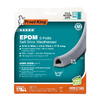I'll see what I can put together.
Sent from my iPad using Home Brew
Sent from my iPad using Home Brew

I made the coil just small enough to squeeze through the opening then expanded it a little to reach the holes through the top once it was inside. I use a cip spray ball the 1/2" one from brewershardware it works good, no need so far to remove the coil. If needed though I can just remove the compression nuts and the orings that seal the nuts to remove the coil.

I would like to know if anyone has had a problem with their comp fittings leaking inside the fermenter. I work with these daily and tho we normally do not have problems, we do have leaks.
I'm not entirely sure the answer to your question, but I think you're on the right track. I'd just duplicate the same settings for all of the tanks/processes in the ladder logic setup area.
You should have instructions on setup of the hysteresis, which will let you control how wide you'll want your setpoint to fluctuate. I think I have mine set at about two or three degrees, and for the most part, the fermentation stays where it is supposed to be.
TD
I was wondering if I could get in on receiving those pages. I was pretty disappointed when the website went down, but alas, a save!
I would like to know if anyone has had a problem with their comp fittings leaking inside the fermenter. I work with these daily and tho we normally do not have problems, we do have leaks.
For all who want the pages, send me your email address and I will send to you via Google drive
Another member might host the file so as to make my life simpler.
A while back someone posted that they had the HTML pages from the defunct plastic conical site? If so I might like a copy of those too.
Also, as an FYI, there had been some changes to the Driver board wiring on the plastic conical site, since I printed out my page. I may have made the annotation. I'll need to verify what that change was, but it didn't seem to be anything critical. I think it was the ground connection.
TD
Sent from my iPad using Home Brew
Borderlands... Sorry.
Sent from my iPad using Home Brew
On my plastic inductor tanks I make the lid air tight by removing the thread ring,and then buying a foamy plastic weather sealer for doors that you can get at Lowes and the like. It is the only one that Lowe's carries with a double bead.
and a sticky side like this:

The one at Lowe's is white and that's what I use. I leave it doubled up and run it just right up next to the holes all the way around the top of the Inductor Tank after removing the threaded flange ring. Then I put the flange ring back on. This sandwiches one of the double seals under the flange ring. The remainder of the 8.5 ft weather seal roll I put on the under side of the lid where the flange and the lid come together. This makes the Inductor tank air tight.
I bought some of this stuff. Please post a pic of how you applied it. My lids are most probably NOT air tight.
Thanks!
TD




I have been KEENLY eyeing those Bru-gear tanks and also the kettles. Its hard to get through to them by email. I'm wanting to go all electric and not sure if I just want to convert my 15 gallon Blichmann kettles with the boil coil, or go another route. I'd really like to upsize to 20 gallon kettles. Bottom line is, PLEASE let me know when you get your conical and and other reviews about Bru-Gear.
Please send, [email protected]
Enter your email address to join: